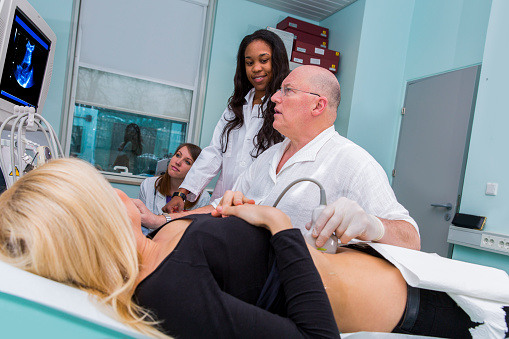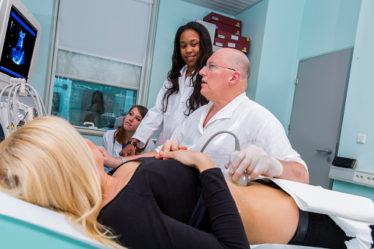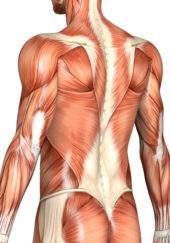Interested in a career in sonography? This article can help answer many of the questions you may have.
What is sonography?
Sonography is a painless non-invasive procedure that uses high-frequency sound waves to produce visual images of organs, tissues, or blood  flow inside the body.
flow inside the body.
What does a diagnostic medical sonographer do?
The Sonographer specialist uses a transducer that produces sound waves into the body in order to visualize anatomy, physiology and pathology. They create a video and a report for the physician. Diagnostic medical sonographers specialize in different parts of the body.
What is the difference between a sonographer and an ultrasound technician?
The main difference is semantic; both sonography and ultrasound technology diagnose ailments using ultrasound technology. In most instances “sonographer” and “ultrasound tech” are interchangeable terms, but sonographers are required to complete additional training and certifications. For this reason, many prefer to be called a sonographer over ultrasound technician.
Why become a sonographer?
Sonographers are in demand and are paid an excellent starting salary. The career is like many advanced care provide careers. Your work provides valuable information for patient care and is a skilled job with mental stimulation and variety.
What are the education requirements to enter the sonography field?
Many education paths are available for prospective sonographers, but the most common is a 2-year degree through an accredited sonography training program. Bachelor’s degrees are also available, as are 1-year certificate programs in sonography for persons already trained in another healthcare field.
What to look for in a sonography program?
Accreditation – The accrediting body for medical sonography programs is the Commission on Accreditation of Allied Health/Education Programs (CAAHEP). The CAAHEP has accredited 150 programs, including those offered by colleges and universities, as well as some hospital training programs.
Admissions Requirements – Make sure to research the admissions requirements of programs that interest you. Vocational, associate and bachelor’s programs may specific courses in math, health, and/or sciences.
Career Goals/ Specialization – Because specialization is so common in sonography, be sure that your program of choice offers your desired specialty. Vascular and cardiac sonography are two particularly specialized programs that not all schools offer.
Curriculum – Look over the program curriculum and make sure that yours provides plenty of hands-on experience. Because sonography is a very hands-on, technical profession, this might be the most important part of your education.
How to get sonography certified?
You can become certified by completing a 2- or 4-year program. You can earn a credential by passing the ARDMS sonography assessments.
Where to find a career in sonography?
You can find hundreds of sonography-specific positions from around the country on UltrasoundJOBS by ARDMS, the largest ultrasound-related career site.
HOW TO BECOME A SPECIALIZED SONOGRAPHER
How to Become an Abdominal Sonographer
What is abdominal ultrasound?
Abdominal Ultrasound uses sound waves to produce pictures of the structures within the upper abdomen. It is used to help  diagnose pain or distention (enlargement) and evaluate the kidneys, liver, gallbladder, bile ducts, pancreas, spleen and abdominal aorta.
diagnose pain or distention (enlargement) and evaluate the kidneys, liver, gallbladder, bile ducts, pancreas, spleen and abdominal aorta.
Why get certified in abdominal ultrasound?
In order to successfully compete for a job as sonographer you will need to sit for the licensure test, you will also need academic credentials and work experience. A certification will give you a professional pride and higher standing in your chosen career field if you choose to work in industry, academia or clinical.
How to get certified in abdominal ultrasound?
To earn a Registered Diagnostic Medical Sonographer (RDMS) credential with an AB specialty, you must pass the Sonography Principles & Instrumentation (SPI) examination and the BR examination within five years. After passing the SPI examination, you can earn additional credentials without having to retake the SPI examination, provided you maintain active status.
Where to find a career in abdominal sonography?
You may look at many internet job sites including: Indeed.com, UltrasoundJOBS by ARDMS and Pronto.com.
How to Become a Breast Sonographer
What is breast ultrasound?
Breast ultrasound imaging of the breast uses sound waves to produce pictures of the internal structures of the breast. It is primarily used to help diagnose breast lumps or other abnormalities that may have been found during a physical exam, mammogram or breast MRI.
Why get certified in breast ultrasound?
In order to successfully compete for a job as sonographer you will need to sit for the licensure test, you will also need academic credentials and work experience. A certification will give you a professional pride and higher standing in your chosen career field if you choose to work in industry, academia or clinical.
How to get certified in breast ultrasound?
To earn a Registered Diagnostic Medical Sonographer (RDMS) credential with a BR specialty, you must pass the Sonography Principles & Instrumentation (SPI) examination and the BR examination within five years. After passing the SPI examination, you can earn additional credentials without having to retake the SPI examination, provided you maintain active status.
The American Society of Breast Surgeons Society’s breast ultrasound certification program is to improve the quality of care for patients with breast disease by encouraging education and training to advance expertise and clinical competency for surgeons who use ultrasound and ultrasound-guided procedures in their practices.
Where to find a career in breast sonography?
You may look at many internet job sites including: Indeed.com, UltrasoundJOBS by ARDMS and Pronto.com.
How to Become a Neurosonographer
What is neurosonography?
A neurosonographer performs ultrasounds on the brain and nervous system of their patients of all ages. Also called neurosonology or neuroimaging, neurosonography utilizes specialized beam shapes and frequencies from a Transcranial Doppler (TCD) unlike traditional obstetric and abdominal sonography machines.
Why get certified in neurosonography?
See above.
How to get certified in neurosonography?
Employers often require neurosonographers to obtain certification, which is available through the American Registry for Diagnostic Medical Sonography (ARDMS). Individuals can obtain the ARDMS designation of Registered Diagnostic Medical Sonographer (RDMS) when the successfully complete the Neurosonology (NE) RDMS credentialing examination. However, as of 2015, ARDMS discontinued the NE RDMS in favor of a Pediatric Sonography (PS) specialty. Those who have the NE RDMS can utilize their certification until 2021 or until their 10-year recertification cycle is complete.
Where to find a career in neurosonography?
You may look at many internet job sites including: Indeed.com, UltrasoundJOBS by ARDMS and Pronto.com.
How to Become an Obstetric and Gynecological Sonographer

What is obstetric and gynecological ultrasound?
Obstetrical and gynecological sonography, commonly referred to as OB/GYN ultrasound, is a diagnostic imaging modality specialty. Obstetrical (OB) sonography refers to the use of ultrasound to visualize and determine the condition of a pregnant woman and her fetus.
Why get certified in obstetric and gynecological ultrasound?
See above.
How to get certified in obstetric and gynecological ultrasound?
To earn a Registered Diagnostic Medical Sonographer (RDMS) credential with an OB/GYN specialty, you must pass the Sonography Principles and Instrumentation (SPI) examination and the OB/GYN examination within five years. To sit for the OB/GYN examination and earn the RDMS credential, First-Time Applicants must select a prerequisite that best meets your education and clinical experience.
Where to find a career in obstetric and gynecological sonography?
You may look at many internet job sites including: Indeed.com, UltrasoundJOBS by ARDMS and Pronto.com.
How to become an Echocardiographer

What is echocardiography?
Echocardiography, is a painless test that uses sound waves to create moving pictures of your heart. The pictures show the size and shape of your heart. A type of echo called Doppler ultrasound shows how well blood flows through your heart’s chambers and valves.
Why get certified in echocardiography?
In order to successfully compete for a job as sonographer you will need to sit for the licensure test, you will also need academic credentials and work experience. A certification will give you a professional pride and higher standing in your chosen career field if you choose to work in industry, academia or clinical.
How to get certified in echocardiography?
ARDMS (American Registry of Diagnostic Medical Sonographers) administers examinations and awards credentials including the areas of diagnostic medical sonography, diagnostic cardiac sonography and vascular technology. RDMS®¹ Registered Diagnostic Medical Sonographer®, RDCS® Registered Diagnostic Cardiac Sonographer®, and RPVI® Registered Physicians Vascular Interpretation®.
Where to find a career in echocardiography?
You may look at many internet job sites including: Indeed.com, UltrasoundJOBS by ARDMS and Pronto.com.
How to become a Vascular Sonographer
What is vascular ultrasound?
Vascular ultrasound is the general term for a non-invasive painless test that uses high-frequency sound waves to image blood vessels including arteries and veins. The veins in the legs are compressed and the blood flow is assessed to make sure the vein is not clogged.
Why get certified in vascular ultrasound?
See above.
How to get certified in vascular ultrasound?
ARDMS RVT Prerequisites
To obtain the RVT credential, you must meet the examination prerequisites and pass the physics and the VT specialty examination within five years:
Physics Examination:
• Sonography Principles & Instrumentation (SPI)
Specialty examination:
• Vascular Technology (VT) – Available on demand
Where to find a career in vascular sonography?
You may look at many internet job sites including: Indeed.com, UltrasoundJOBS by ARDMS and Pronto.com.
How to become a Musculoskeletal Sonographer

What is musculoskeletal ultrasound?
Musculoskeletal Ultrasound imaging uses sound waves to produce pictures of muscles, tendons, ligaments and joints throughout the body. It is used to help diagnose sprains, strains, tears, and other soft tissue conditions. Ultrasound is safe, noninvasive, and does not use ionizing radiation.
Why get certified in musculoskeletal ultrasound?
In order to successfully compete for a job as sonographer you will need to sit for the licensure test, you will also need academic credentials and work experience. A certification will give you a professional pride and higher standing in your chosen career field if you choose to work in industry, academia or clinical.
How to get certified in musculoskeletal ultrasound?
The Musculoskeletal sonographer (MSKS) examination is a windowed examination that is administered during select times of the year at Pearson VUE test centers. Scores for each windowed examination period are available approximately 60 days after the testing period ends.
Physicians and advanced care providers are eligible to earn the RMSK certification. The MSK examination requires applicants to be licensed, practicing physicians or advanced care professionals who have clinical musculoskeletal ultrasound experience. Please consult the full list of prerequisites to see if you qualify to apply for the musculoskeletal ultrasound certification.
The MSK examination takes four hours to complete and contains 200 questions. You’ll be assessed on your knowledge and abilities in the areas of muscles, joints, ligaments, tendons and soft tissues of the body. In order to earn your MSK ultrasound certification, you need to demonstrate that you have basic competency of the subject. Scores for each examination period are available approximately 60 days after the testing period ends.
Where to find a career in musculoskeletal sonography?
You may look at many internet job sites including: Indeed.com, UltrasoundJOBS by ARDMS and Pronto.com.